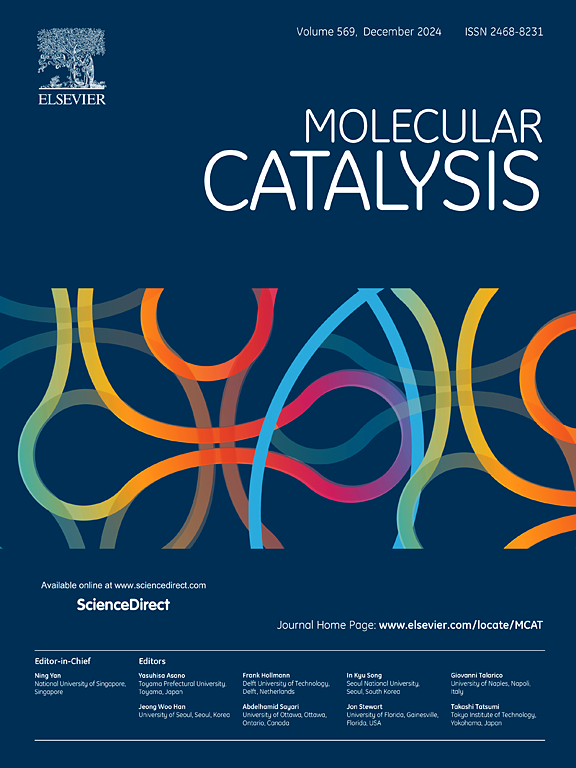Rhombohedral Fe2O3/LaCoO3 nanomaterials as high-performance electrocatalysts for OER: Synthesis and electrochemical performance
IF 4.9
2区 化学
Q2 CHEMISTRY, PHYSICAL
引用次数: 0
Abstract
The development of stable, non-noble, and sustainable nanomaterials offers a viable pathway for enhancing water electrolysis operations, especially in facilitating efficient Oxygen Evolution Reaction (OER). In this study, we have prepared a rhombohedral composite nanomaterial (Fe2O3/LaCoO3) for the OER by co-precipitation method. Samples were thoroughly analyzed using multiple techniques to ensure comprehensive characterization, including X-Ray Diffraction (XRD) for crystallographic structure determination, Scanning Electron Microscopy (SEM) for surface morphology observation, Energy Dispersive X-ray Spectroscopy (EDX) for elemental composition analysis, mapping analysis to visualize spatial distribution of elements, and Fourier Transform Infrared Spectroscopy (FTIR) for identifying functional groups and chemical bonds. Prepared electrocatalyst reveals robust OER performance with an overpotential of 311 mV to achieve the 10 mAcm−2 current density in alkaline media. Significantly, this catalyst offers a low Tafel slope of 76 mV dec‑1 and a charge transfer resistance of 532 Ω with excellent Linear Sweep Voltammetry (LSV) cycling stability. The improved electrocatalytic performance results from the synergistic interaction among La, CoO3, and Fe2O3, which typically enhances the overpotential, charge-mass transport, and stability. This strategy offers a viable pathway for synthesizing and optimizing nanomaterials for advanced electrochemistry.

菱面体Fe2O3/LaCoO3纳米材料作为OER高性能电催化剂的合成及其电化学性能
稳定、非贵金属和可持续的纳米材料的发展为提高水电解操作,特别是促进高效的析氧反应(OER)提供了一条可行的途径。在本研究中,我们采用共沉淀法制备了一种用于OER的菱面体复合纳米材料(Fe2O3/LaCoO3)。采用多种技术对样品进行全面分析,以确保全面表征,包括用于晶体结构测定的x射线衍射(XRD),用于表面形貌观察的扫描电子显微镜(SEM),用于元素组成分析的能量色散x射线光谱(EDX),用于可视化元素空间分布的映射分析,以及用于识别官能团和化学键的傅里叶变换红外光谱(FTIR)。制备的电催化剂具有良好的OER性能,过电位为311 mV,在碱性介质中达到10 mAcm−2的电流密度。值得注意的是,该催化剂具有76 mV dec - 1的低塔菲尔斜率和532 Ω的电荷转移电阻,具有出色的线性扫描伏安(LSV)循环稳定性。La、CoO3和Fe2O3之间的协同作用提高了电催化性能,增强了过电位、电荷-质量传递和稳定性。该策略为先进电化学纳米材料的合成和优化提供了一条可行的途径。
本文章由计算机程序翻译,如有差异,请以英文原文为准。
求助全文
约1分钟内获得全文
求助全文
来源期刊

Molecular Catalysis
Chemical Engineering-Process Chemistry and Technology
CiteScore
6.90
自引率
10.90%
发文量
700
审稿时长
40 days
期刊介绍:
Molecular Catalysis publishes full papers that are original, rigorous, and scholarly contributions examining the molecular and atomic aspects of catalytic activation and reaction mechanisms. The fields covered are:
Heterogeneous catalysis including immobilized molecular catalysts
Homogeneous catalysis including organocatalysis, organometallic catalysis and biocatalysis
Photo- and electrochemistry
Theoretical aspects of catalysis analyzed by computational methods
 求助内容:
求助内容: 应助结果提醒方式:
应助结果提醒方式:


